Storm sewer cleaning technology: an overview of popular ways
Owners of cottages and country houses know firsthand how important it is to equip storm sewers so that melt and rainwater do not spoil the finish and flood the foundation. But it’s not enough to organize the correct system for the disposal of wastewater - without regular maintenance, it will quickly fail and “report” about it with drips on the walls and puddles near the house during a heavy rainfall or spring drop.
To avoid this, timely prophylaxis is required and the ability to quickly eliminate blockages. Therefore, let us consider in detail what methods the technology for cleaning storm sewers has, depending on the type of construction. Also in this article we focus on the causes of clogging of drainage systems and preventive measures.
The content of the article:
Varieties of storm sewers
The purpose of storm storms is to collect water from precipitation and to discharge it into a special tank or just beyond the territory of the site through a pipeline network or bypass gutters. Any design of a drainage system can cope with this task.
But in order to choose the most effective way to clean and prevent sewage blockages, you first need to find out which system protects your home from rain and thawed snow.
Open (surface) - the most budgetary and simplest construction, which is equipped with country houses. It is a complex of trays, pipes, gutters, which are held on the roof and walls of the building, - spillway system. According to them, water enters the points of water intake - surface drainage ditches, equipped around the perimeter of the entire site or only at the local area, and is discharged into the ground.

The closed - upper part of the stormwater drainage system represents the same system of pipes and gutters, only the collected water is already collected in underground sewer pipes, where other sewage from the house also flows, then into the collector and only after that it is diverted to the drainage system. In some cases, an additional pump is installed that controls the speed of the effluents.
Such a system copes with the removal of excess moisture from the site without flooding the soil, the formation of puddles and other flaws in the operation of open storms. Of the minuses, an expensive installation can be noted.
In addition, for the layman it can be an overwhelming task to make the correct calculation of the required number of components, the length and diameter of the pipes, determine the depth of their installation, the desired slope and other nuances. A detailed analysis of the features of the design and calculation of storm sewers we gave in this article.
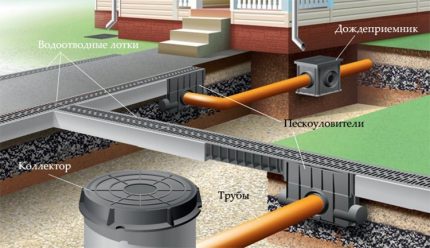
Therefore, for suburban cottages and country houses, designed for a longer period of stay than a couple of weekends in a year, most often install a mixed sewage system. In fact, this is a simplified version of a closed system
In this case, instead of a complex maze of sewage, water is diverted to a storage tank or septic tanklocated on the territory is defended, cleaned and then can be used for irrigation or other technical purposes.
Another option for the disposal of wastewater is withdrawal to nearby lakes and rivers, but for this the water must be filtered so as not to clog the pond (which is fraught with an impressive fine).
Causes of clogged drainage systems
In any system, irrespective of the type of its construction, various small litters regularly penetrate - fruit tree bones, insects, fallen twigs and leaves, bird feathers and nesting material.

But there are other reasons for blockages:
- Incorrect installation. If the required angle of inclination towards the catchment is not maintained in the pipeline (or is absent altogether), the water will stagnate and garbage will accumulate faster. You can verify compliance with the norms using the construction level (optimal indicator is 2-5 mm / linear meter).
- Curvilinear pipe laying. If the system has many sharp turns, blockages are inevitable. Therefore, when planning the pipeline, try to minimize bends. Yes and with self design or accepting work from builders will first familiarize themselves with SNiP 2.04.01-85.
- Heavy rainfall. After heavy rain, the system can be flooded with fine sand, silt or mud. It is difficult to prevent natural disasters, but it is recommended to check the system after them and arrange an unscheduled cleaning.
- House clogging. For closed systems in which storm sewage is combined by a pipe that discharges domestic sewage, the problem can most often be solved by cleaning the house pipe.
- Construction works. If the roof was blocked or the facade decoration was updated, upon completion of the repair it is necessary to check whether the wind brought foam gutters and pipes, fragments of plaster and other materials, which in the next rain turn into an impenetrable cork for water.
In some cases, the penetration into the system of petroleum products may also cause a blockage. True, this phenomenon can be attributed to force majeure, which disable storm storms much less often than the banal accumulation of leaves.
But if this happened, you should immediately call specialists who will establish the system and prevent soil and groundwater pollution.
System Cleaning Methods
Depending on the drainage construction devices and the type of its elements (the same gutters can be completely open or closed, but with nets or perforations), you can choose the most convenient way for you to care for the system.
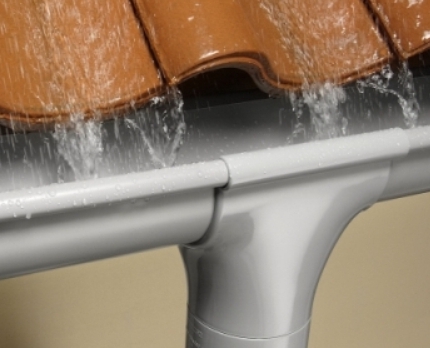
Consider all possible ways in more detail.
Method # 1 - mechanical using improvised means
The most affordable and popular method of cleaning, which is perfect for all open storm storms, is mechanical. It does not require any special equipment or special skills, except for caution when working at height. The essence of the work is the mechanical removal of accumulated debris.
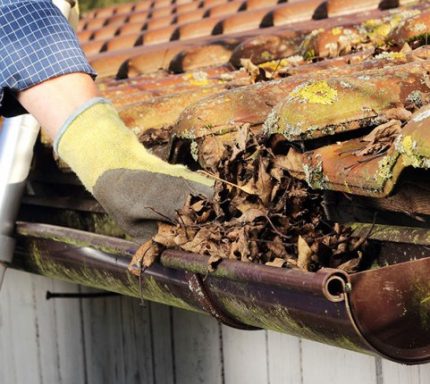
To accomplish this task, you will need simple equipment: a ladder, a brush with plastic or synthetic fiber bristles, a spatula or a scoop, a garden hose with a water connection.
An excellent tool can be made with your own hands from an ordinary plastic bottle by cutting a semicircular hole in it along the diameter of the gutter. Just before cleaning, do not forget to protect your hands with tight gloves to protect yourself from sharp fragments and insects.
Cleaning should be performed from the highest point, covering all elements of the system:
- From the gutters laid on the roof, the accumulated debris must be collected on a dustpan and sent to a bag for further disposal. Just do not push the leaves and other litter into the drainpipes, it is better to sweep everything out with a broom or brush, and then remove the adjoining territory.
- Funnels - connecting elements that combine gutters and rain pipes - are most often equipped with gratings that need to be removed and washed. If there is no such protection, you can simply clean the elements under the pressure of the water, removing traces of dirt and small debris, and large ones can be pre-assembled by hand.
- The drainpipes along which the drains flow down are the easiest to also rinse under good pressure, helping yourself with a brush. If you cannot reach the blockage with your hands and a brush, and it does not lend itself to water, you can use a plumbing drill or cleaning tapes. Only such equipment should be used with caution so as not to scratch the protective coating of the pipes, which leads to corrosion of the metal.
- Drainage channels must first be removed from the protective grilles (if installed), cleaned of debris and rinsed with water.
- Now inspect the sewage reservoir (ditch, drainage field), if necessary, remove the sludge and update the filter layer.
- It remains to return to place all the grilles and other elements of the system and check its operation using the same hose with a water pressure.
Specialized sectional, rod or drum type cleaning machines can facilitate manual labor, however, they are more designed to remove blockages in pipes, rather than cleaning open gutters.
But there is an option for those who do not want to collect leaves on their own - a robot vacuum cleaner.

It is worth installing this miracle of technology on the roof, as it begins to move around the perimeter of the gutter system, removing dirt and accumulation of debris with brushes. It can work from an electric network or on batteries.
Method # 2 - washing under pressure of water
A closed or mixed system can also be cleaned mechanically in the upper (ground) part. True, you will have to carry out preliminary preparation - remove the nets or grilles from the gutters, arm yourself with a brush on a long stick or a blower.
But to clean the underground drain, you may need hydraulic equipment. A simple garden hose is not enough here, since its pressure is not enough to break plugs of sand, dirt and wet leaves. Hydraulics provide a powerful water stream that perfectly flushes uncomplicated debris from the pipeline.
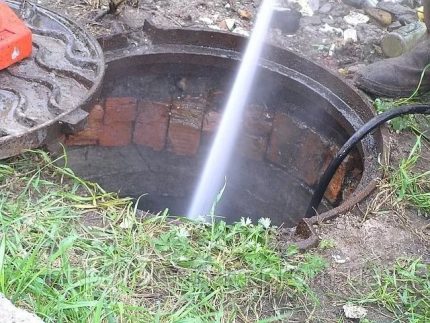
A blockage can be detected through manholes or with the help of video diagnostics - modern devices are equipped with a sensor and a cable, which, passing through the pipes, records or immediately transmits to the display an image that clearly demonstrates the state of the sewage system from the inside.
Typically, systems for cottages and small houses are equipped with elements with a diameter of 20-22 cm. For washing such a sewage, a household car wash with a capacity of 120-150 bar is enough.
But to clean the wide pipes that are equipped with large cottages, you will have to call specialists with professional hydraulic equipment, which is equipped with a long inlet hose and a powerful pump.
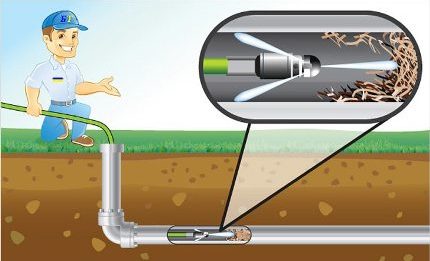
Professional hydraulic machines also provide nozzles that can handle both simple and complex types of blockages:
- Universal - are used for ordinary washing of a drain and removal of soft garbage.
- Bottom - effectively remove leaves, pieces of polyethylene, soil, silt and other accumulations from stormwater.
- Punching - designed for crushing building debris, accumulation of leaves and branches, sand, paper.
- Rotary chain - they will cope with old deposits and compacted debris, which are not amenable to even strong water pressure.
To use the hydrodynamic method of cleaning pipes, the site must have an uninterrupted supply of water and electricity. Otherwise, you will have to look for equipment that runs on gasoline, or call a car with a tank.
But such a technology, unlike other methods of cleaning the sewage system, absolutely guarantees the integrity of all drainage elements.
Method # 3 - thermal or steam cleaning
For mixed and gated systems combined with common sewerage, steam cleaning technology can be used. Here, blockages often occur due to fat growths on the walls of the pipeline, which are not amenable to cold water, but literally disappear before the eyes under the influence of hot steam. To do this, the water is heated to a temperature of 140 degrees and rinses the pipes.
But remember, the thermal method is recommended to be used as the final stage after mechanical and hydrodynamic cleaning. But it is not worth using it as an independent method - the risk of injuries is high, and the result is unpredictable.
Method # 4 - using chemicals
In cases where other cleaning technologies have proven powerless against complex clogging, resort to chemical reagents.
Such a need may arise if a large amount of fatty waste has entered the system that has stuck together in dense clods with the debris there, or the design is so complex and winding that the cork is technically unavailable for punching rope, and water does not cope with the task.

Use these chemicals on their own with caution - most of them are toxic and can cause severe poisoning if they enter groundwater. Therefore, it is possible to clean the sewer with this method only with biochemical preparations, and even then, provided that the contaminated water first passes through filtration and does not get into drinking sources.
Methods for cleaning directly stormwater
Cleaning the direct storm sewer consists in periodically emptying the sand traps and removing plugs from the silt and sand from the channels of the underground system:
What is the danger of clogging the system?
If, having studied all the technologies for cleaning storm sewers, you are seriously thinking in the direction of "Do I need it," take a note and a list of problems that may result from a lack of maintenance of the system.
- Stagnation of water in pipes and gutters creates an additional load on the fasteners. They may simply not sustain and bring down the system.
- The accumulated debris clogs the drains, and the water not only rinses the foundation of the house, but also penetrates through the ceilings and walls - yes, damp spots and moldy finish can be a clear indication of a malfunction on the roof.
- Fallen fruits and berries create favorable conditions for the settlement of entire colonies of wasps, hornets, ants, and under moist leaves moss, mold and even mushrooms can grow.
- In dry summers, trash on the roof may well cause a fire.
As you can see, regular cleaning of rain showers is not only a matter of comfortable housing in the house, but also your safety.
Blockage Prevention
Experts recommend checking the operation of open stormwater and removing accumulated litter at least 2 times a year. After the autumn leaf fall, all the garbage must be removed in order to prepare the drainage system for winter, and in early spring to verify the integrity of the mounts after frost and thaw.
But when tall trees grow near the building, you will have to look at the roof much more often if you do not want to know about the need for cleaning work from water flowing down the walls and roof of the house to bypass rain pipes. But if all the gutters in a closed type construction - just one inspection a year is enough.
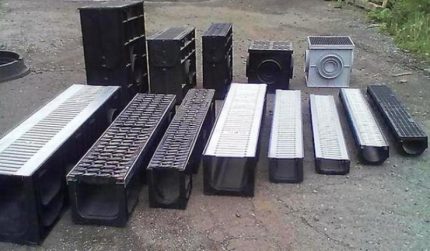
The following preventative measures will help prevent the formation of blockages:
- Reducing the amount of debris entering the drainage system will help with special visors for funnels and fine-meshed nets / grids covering the gutters. If the system is already installed and there is no desire to upgrade part of its elements, you can fill the gutters with porous foam. It is applied by spraying, takes the form of a drain and does not allow large debris to pass into the pipes (although this protection needs to be updated every 3-5 years).
- Since the external stormwater system is much easier to clean than the underground one, it is possible to equip the drains with several grating traps that will stop particles of soil, sand and leaves. To prevent blockage, it will be enough to regularly check the “control points” and remove garbage from them.
- If a closed or mixed type system is installed on your site, it is worth installing in the pipes that discharge household drains from the house, grease traps. This will help to avoid hard to remove formations on the walls of the sewer.
- If the underground part of the system has complex turns, it is worthwhile to install inspection wells in potential clogging areas so that in case of problems you do not have to dig pipes.
In addition to additional system protection, it is worth taking care of wastewater treatment. To do this, it is necessary to equip sedimentation tanks with drainage fields or separators that mechanically separate water from sediment and other inclusions, or install an autonomous sewage system.
Conclusions and useful video on the topic
More about the organization of the drainage system on the site:
And this video details how to install a grid to protect the drain from leaves with your own hands:
Professional cleaning using hydrodynamic technology - how complex blockages are washed:
Compliance with building codes during installation, regular waste removal and prevention - three elephants for the smooth operation of the entire sewer system.
But if none of the popular cleaning technologies inspired you for labor exploits, you should agree with a cleaning company about the periodic cleaning of the storm. Believe me, such a service will cost much less than eliminating clogged blockages and repairing a flooded house.
And what method do you use for cleaning stormwater? Do you take preventative measures to prevent the formation of blockages? Share with other users your secrets of caring for a common sewerage system - leave your comments and useful tips in the comments section.

 Calculation of storm sewers: an analysis of important design features
Calculation of storm sewers: an analysis of important design features 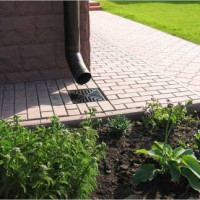 Do-it-yourself storm water drain: all about the installation of a storm shower for a summer house and a private house
Do-it-yourself storm water drain: all about the installation of a storm shower for a summer house and a private house  Which gutter is better - plastic or metal? Comparative review
Which gutter is better - plastic or metal? Comparative review 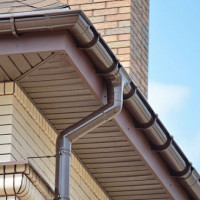 How to make spillways from the roof: general recommendations for arranging a drainage system with your own hands
How to make spillways from the roof: general recommendations for arranging a drainage system with your own hands 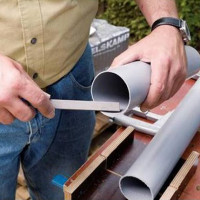 DIY roof gutters: instructions for self-manufacturing a drainage system
DIY roof gutters: instructions for self-manufacturing a drainage system  How much does it cost to connect gas to a private house: the price of organizing gas supply
How much does it cost to connect gas to a private house: the price of organizing gas supply  The best washing machines with dryer: model rating and customer tips
The best washing machines with dryer: model rating and customer tips  What is the color temperature of light and the nuances of choosing the temperature of the lamps to suit your needs
What is the color temperature of light and the nuances of choosing the temperature of the lamps to suit your needs  Replacement of a geyser in an apartment: replacement paperwork + basic norms and requirements
Replacement of a geyser in an apartment: replacement paperwork + basic norms and requirements
It is clear that it is necessary to clean the stormwater. However, I prefer mechanical methods, since chemical ones can damage the materials themselves used in the construction of the system. That is why I would recommend that those who have a lot of deciduous trees on the site use exactly open options for storm sewers. At least in such cases, mechanical cleaning will be most effective.
There was a blockage in the closed pipe, we first wanted to use the service of a company that leased a canal washing machine. But they are so expensive. And if this will be repeated constantly? They asked a neighbor for a car wash, bought a longer high-pressure hose and cleaned everything well. After that they put a rubber trap in front of the pipe, the problem did not recur. If the net is filled with dirt just need to shake it off.
A classic example of how a person solved the symptoms, and then eliminated the very cause of the problem 🙂 In this case, we could say that if the trash catcher was mounted immediately, there would be no problems at all. For those who constantly have problems with blockages of storm sewers, your example is very illustrative.
To catch leaves and other large debris, a drain ladder with a grate is enough, but it is also necessary to equip the drain with a special sand trap. Such an integrated approach will avoid critical blockages in storm sewers.
At my dacha there are a lot of deciduous trees and pipes are constantly clogging. The neighbors recommended contacting a company specializing in stormwater service, and they really helped, now there are no problems with blockages.